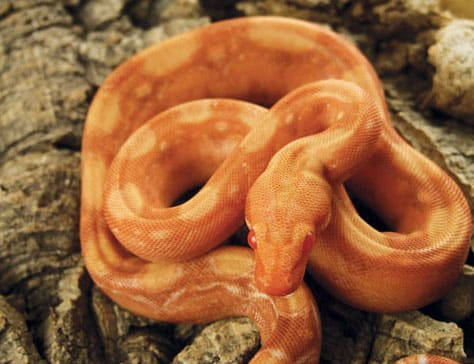Boa constrictor imperator is one of the more beautiful constrictors
I was 17 years old when I entered a pet store to buy bird food and a mouse for my gopher snake. The owner, a big guy who introduced himself as Rich Ihle, approached me in the bird department. "If you like those birds," he said. "You will really like this." He took me to the other side of the store and placed a female red-tail boa (Boa constrictor imperator) in my hand. She was incredibly smooth compared to the snakes I'd grown up with in Arizona, and she sat calmly in my hands, studying me while I studied her. Within the hour I put money down on the snake, and I immediately started planning how to get another. Her name was Ruby, and she was the foundation of my boa colony for the next 11 years.
That encounter with Rich was 22 years ago. Now I'm the manager of his websites. I have made boa constrictors a lifelong passion, and working with a large number of them has taught me a ton about husbandry.
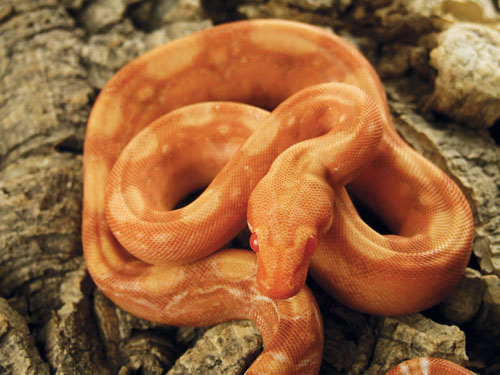
This albino blood boa is the first ever produced. It is a combination of a blood boa from Central America and a Sharp-strain albino boa.
Cold-Blooded Facts
Boa constrictors (Boa constrictor ssp.) are ectotherms, which means they rely on external resources to maintain their body temperatures. When a boa senses its body needs warmth, it goes in search of warmer conditions, such as a basking spot. It may only sit in that spot for 20 minutes, but instinctively it knows how long it needs to be there to maintain a certain temperature.
In captivity snakekeepers have to provide the necessary temperature options for their boas, so the reptiles can decide what temperature they need at any given time. If owners don't give their boas access to these options, including a warm enough basking spot, their pets could encounter health problems such as parasites, which can quickly wreak havoc if not dealt with as soon as symptoms are noticed.
A boa enclosure's ideal ambient air temperature is about 84 to 85 degrees Fahrenheit. The basking spot should be between 95 to 100 degrees, and the cool side should drop to 83 to 84 degrees.
With these temperature ranges, your boa should spend a sufficient amount of time on each side of the enclosure depending on its feeding schedule and humidity regimen. If your boa spends all of its time on the cool or hot side of its cage, that's a good indication something is wrong. Generally speaking, if your boa never leaves the basking spot, then the basking temperature might be too low, or the boa might be suffering from an illness, causing it to seek constant warmth.
Enclosure Necessities
My personal rule of thumb is to provide an enclosure large enough for the boa to coil completely under the basking site and still have enough room for at least three-fourths of the cage floor to be a cooler temperature. Many caging and heating options are available. Rack systems with stackable plastic cages work great for medium to large boa collections. They are simple to organize and keep clean.
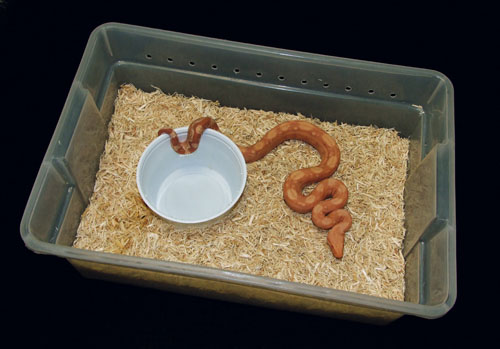
A close look at the scales of this 12-week-old coral sunglow male's sides reveals white and pink scales. Someday they will turn rich-pink and red-coral colors..
Years ago, aquariums were the way to keep boas. A 10-gallon aquarium was – and still is – an ideal size for one baby boa. The only problem with aquariums is their screen lids; they don't hold in humidity. I recommend that aquarium-users make a new top out of pegboard. This material retains humidity while allowing adequate air circulation. A fluorescent lighting fixture is simple to attach, and handles can be added to the top for ease of use.
A better option for housing a new baby boa is a rubber storage container. My company uses 12-quart Rubbermaid storage containers to house baby boas up to 6 months old. Then they're moved into 28-quart sweaterboxes until they require larger quarters. Our baby-snake room is constructed with custom pegboard shelves built by Rich. Flexwatt heat tape is securely fastened along the back of the shelf, which heats just one-fourth of each baby box.
Once your red-tail boa measures 3 or 4 feet in length, it needs adult-sized caging. A sufficient-sized cage for adult boas measuring up to 8 feet long is a container with 8 square feet of floor space, such as containers measuring 4 feet by 2 feet. A cage height between 18 and 24 inches is OK. For boas longer than 8 feet, we have a number of rubber containers measuring 6 feet long by 2 feet wide by 2 feet tall. These are stacked in custom rack systems that provide excellent air circulation and temperature control.
Substrate depends on the snake's age. We use aspen bedding for babies and juveniles. Once they are adults ready to breed, we use corrugated cardboard because it is easy to clean. Also there aren't particles, which can get in the way of the snakes' copulation. Newspaper is another good substrate option. Although many snakekeepers offer their snakes hides, we do not because we feel it makes them more reclusive and shy. However, our snakes are kept in a rack system, so they aren't as exposed as those in display enclosures.
Keep It Tropical
Boa constrictors come from the rain forests and jungles of Central and South America where water is abundant in liquid form and in the air as humidity. Thus fresh-filtered drinking water and proper humidity are essential to the survival and health of captive boa constrictors. Fresh, humid air is critical to their respiratory system.
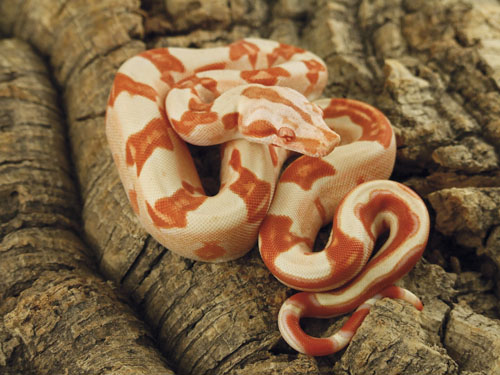
This sunglow male was born from a pair of adult Kahl-strain sunglows. His grandfather was a coral sunglow and his father was a Kahl sunglow.
Boas do best with humidity ranging between 60 and 80 percent; occasionally it can go higher. Accomplish this humidity with a spray bottle and daily misting, with a more elaborate electric humidifier, or even with a complete open-air system that pushes evaporative cooled air through the enclosure. Evaporative cooled air is also called "swamp cooling," and it is essentially air pulled through damp pads to increase the air's moisture level as it flows into a structure.
Our facility is a perfect example of an open-air system. It includes an evaporative cooler that draws air into the building, a second evaporative cooler that pushes air from the front room to the main room, and then an industrial exhaust fan that pushes the air out of the building. Fans are strategically placed to maximize airflow in every square inch of the facility. If you have this option in your home, or at least in the boa collection room, use it to increase the overall air humidity.
Healthy Food Choices
Captive boa constrictors readily accept rodents. Although those keeping larger constrictors are often required to feed rabbits and pigs, the red-tail boa doesn't reach a size that necessitates this, and rats and mice are usually sufficient.
Some hobbyists feed their snakes live rodents and some feed thawed, previously frozen rodents. Live rodents present many more risks than the frozen variety. They might bite or scratch the snake, or seriously injure it by chewing on its skin and muscle. If feeding live prey to your boa, always keep an eye on the event at least until the snake constricts and kills its meal.
The simplest and safest way to feed your snakes is with thawed, previously frozen prey items. These are available in small frozen packs at your local pet store, online or through a local distributor.
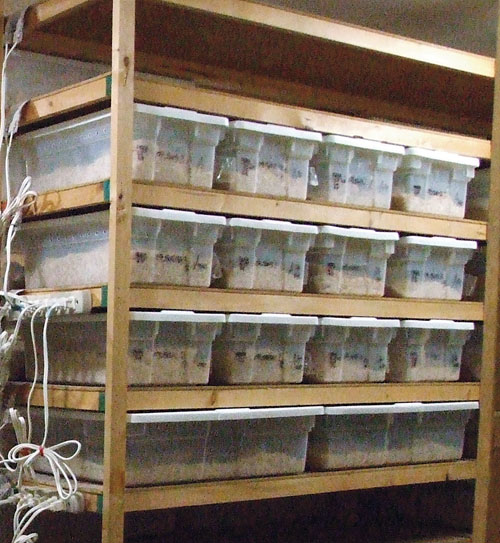
The author keeps baby boas in 12-quart rubber storage containers. Once the snakes reach 3 to 4 months old, they are moved to a 28-quart sweaterbox container.
A boa's growth rate is dependent not only on its genetics but also on its feeding program. Boas fed every week and kept in a warm, humid environment grow faster than boas fed twice a month and kept only moderately warm to the point they cannot properly thermoregulate.
Some hobbyists try to speed up their boas' growth to get them to breeding size much sooner than normal by manipulating external variables. This is not a good practice because it can shorten the boa's life by forcing its organs to grow too quickly to support the rest of the body.
It is best to offer regular weekly meals for baby boas and then settle into a maintenance feeding schedule for older males and breeding females. The ideal feeding schedule for a baby boa is every five to seven days, and then feed them once weekly through their adult life. A good rule of thumb regarding prey selection is to choose a meal the same width or just slightly bigger than the thickest part of the snake's body. Baby boas do great on hopper mice at first, and adults average one to two jumbo-sized rats per week.
Health Watch
It's important to observe your boa and learn its patterns and habits. Note its routines, such as what time of day it resides on the cage's cool side or when it is hungry and cruising around its enclosure. By logging or journaling events such as feeding, defecating and shedding, you will learn to predict behaviors and diagnosis problems or potential negative situations quicker.For example, if you know that boas are normally quiet creatures with a clean nose and face, you can respond faster when you hear a cough, or see a runny or constricted nostril.
Remember, a healthy boa kept in the proper heat and humidity almost always sheds a complete skin. If your boa sheds in small pieces, you must determine whether the cause is a lack of heat, humidity or something worse.
Boakeepers' most dreaded fear should be mites. These tiny insects feed on the blood of snakes and lizards. They look like a single, round piece of pepper, and they're usually first detected in a boa's water bowl. Mites are heavily suspected of transmitting inclusion body disease from boa to boa. Often nicknamed "reptile AIDS," IBD is a fatal disease in boas with no known cure. There are many efforts in the boa community to develop early detection strategies and/or vaccines that will prevent IBD from destroying a boa or python. Make sure your reptile veterinarian is familiar with the efforts being made to fight against this deadly disease. The bottom line is that if one boa with IBD is infected with mites, every nearby boa that comes in contact with a mite has a significant chance of contracting IBD and/or other related infections.
Red-tail boas are incredibly beautiful animals. They can be resilient when cared for properly, yet they also can be the most fragile of creatures when neglected and mismanaged. If you continue to search out new information, provide proper captive care and use common sense while observing your boas, they will reward you for many years.

